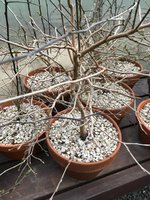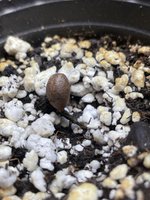You are using an out of date browser. It may not display this or other websites correctly.
You should upgrade or use an alternative browser.
You should upgrade or use an alternative browser.
About Princess Persimmon
- Thread starter NaoTK
- Start date
roberthu
Chumono
Yeah sorry…Really ??? So does that mean I won’t get any fruits ? Thanks
Make flower’s receptacle is smaller than female’s. If you look at the photos I posted, those receptacles are very long and can almost cover the fruits. Yours look like the male flowers on my other trees.
vp999
Masterpiece
Argggg...Thanks man for informing me man.Yeah sorry…
Make flower’s receptacle is smaller than female’s. If you look at the photos I posted, those receptacles are very long and can almost cover the fruits. Yours look like the male flowers on my other trees.
Holy heck, are your guys' trees already flowering and fruiting?! In Oregon I am barely getting bud movement...
@roberthu Did you have a male pollinate to get that fruit or did it bear without pollination?
I now have 2 fruiting trees. 1 big leaf deciduous from Julian and 1 small leaf evergreen from Brent.
View attachment 425732View attachment 425733
@roberthu Did you have a male pollinate to get that fruit or did it bear without pollination?
roberthu
Chumono
I did have male flowers present when the females bloomed and I saw bees very often thanks to the FL warmth. I am not sure if male is necessary for fruits to set. But last year, I had both male and female flowers too but no fruit. All female flowers dropped before fruit set. It was still quite cold in Atlanta last year when they flowered and there was no bee or anything else to pollinate. We also had extensive rains last year. So not sure exactly what caused no fruit.Holy heck, are your guys' trees already flowering and fruiting?! In Oregon I am barely getting bud movement...
@roberthu Did you have a male pollinate to get that fruit or did it bear without pollination?
This is the first time I have persimmon fruits!
River's Edge
Imperial Masterpiece
namnhi
Masterpiece
Only if you can bear children then this one will have fruits.Got this princess persimmon today because it was full of flowers, hopefully I will get some fruits.
View attachment 425768View attachment 425769
vp999
Masterpiece
Only if you can bear children then this one will have fruits.
Thanks for informing me, I returned the tree the very next day since it is a male. There's no way i'm spending that kind of money on princess persimmon that's not going to have any fruits lol.
vp999
Masterpiece
Still hurts man ...You got any female PP you wanna sell me bro? I am desperate for a Shohin one lol.
badatusernames
Omono
Well, I got one. Main trunk is largely dead, took some cuttings of suckers where they were growing from less than ideal places, wondering if they’re why the big trunk mostly died. There’s one coming off the top of the base that I’m thinking I MAY be able to use as a leader to save some girth beneath, I really don’t know. The other “trunks” are further from the main trunk but thinking they may be suckers too.
Figured this was a good way to play with the species. Keeping it in under lights for now as the nursery I got it from keeps the greenhouse a bit warm for the season and easy to shock the leaves that have come out (same reason I have the azalea there and it’s flowering out). Feeding heavily, not even worried about fruit or gender yet. I just want to see what happens. I do have a book coming about them. Page one will probably read: “what the hell do you think you are doing, you specifically, stop”. But I gotta try.
I will be glad when I can move all this stuff outside…
Figured this was a good way to play with the species. Keeping it in under lights for now as the nursery I got it from keeps the greenhouse a bit warm for the season and easy to shock the leaves that have come out (same reason I have the azalea there and it’s flowering out). Feeding heavily, not even worried about fruit or gender yet. I just want to see what happens. I do have a book coming about them. Page one will probably read: “what the hell do you think you are doing, you specifically, stop”. But I gotta try.
I will be glad when I can move all this stuff outside…
Nybonsai12
Masterpiece
penumbra
Imperial Masterpiece
Mine are 3 years old now from seed. Is there any way to determine sex other than waiting for flowers?
Canada Bonsai
Chumono
- Messages
- 653
- Reaction score
- 2,266
Mine are 3 years old now from seed. Is there any way to determine sex other than waiting for flowers?
Not to my knowledge. There was a discussion on this forum at some point about the possibility of distinguishing females and males based on foliage density, but now that I have 35 female cultivars and 3 male strains it's clear to me that foliage density varies greatly within the species and that seems to be based more on cultivar/strain than it does on whether they are female or male.
namnhi
Masterpiece
I have both male and female. There is nothing different about the leaves. You going to have to wait for it. Should be flowering in another year or two.Mine are 3 years old now from seed. Is there any way to determine sex other than waiting for flowers?
Since we are on the topic, you should know that persimmons are what they call Subdioecious. You will find one of these situations (and I have examples of each and can share more details if needed):
1. All flowers are male (they say ~60% of individuals in some books)
2. All flowers are female (they say ~40%)
3. Male flowers on some parts of the plant, female on other parts (rare.) Like zucchini flowers.
4. Bisexual "perfect" flowers all over the plant (rare.) The flower has both male and female parts on the same flower, like a tomato.
The most interesting group to me are the bisexual individuals. That is probably the weirdest sentence ever typed on Bnut. The flowers have pronounced stamen, but the stigma varies greatly in expression. The sepal is tied to the stigma expression, and you see a lot of variation in how female the flower is. Like some flowers are 100% bisexual with very clear female and male parts, and some are like 10% bisexual with only a small female part.
There's a lot of interesting papers on the topic. If you think about how taxing it is to make fruit, in a competitive environment like a forest it is more beneficial to grow quickly as a male.
1. All flowers are male (they say ~60% of individuals in some books)
2. All flowers are female (they say ~40%)
3. Male flowers on some parts of the plant, female on other parts (rare.) Like zucchini flowers.
4. Bisexual "perfect" flowers all over the plant (rare.) The flower has both male and female parts on the same flower, like a tomato.
The most interesting group to me are the bisexual individuals. That is probably the weirdest sentence ever typed on Bnut. The flowers have pronounced stamen, but the stigma varies greatly in expression. The sepal is tied to the stigma expression, and you see a lot of variation in how female the flower is. Like some flowers are 100% bisexual with very clear female and male parts, and some are like 10% bisexual with only a small female part.
There's a lot of interesting papers on the topic. If you think about how taxing it is to make fruit, in a competitive environment like a forest it is more beneficial to grow quickly as a male.
Last edited:
HamburgerTrain
Shohin
piiiiiiiiiiiiiiics!Since we are on the topic, you should know that persimmons are what they call Subdioecious. You will find one of these situations (and I have examples of each and can share more details if needed):
1. All flowers are male (they say ~60% of individuals in some books)
2. All flowers are female (they say ~40%)
3. Male flowers on some parts of the plant, female on other parts (rare.) Like zucchini flowers.
4. Bisexual "perfect" flowers all over the plant (rare.) The flower has both male and female parts on the same flower, like a tomato.
The most interesting group to me are the bisexual individuals. That is probably the weirdest sentence ever typed on Bnut. The flowers have pronounced stamen, but the stigma varies greatly in expression. The sepal is tied to the stigma expression, and you see a lot of variation in how female the flower is. Like some flowers are 100% bisexual with very clear female and male parts, and some are like 10% bisexual with only a small female part.
There's a lot of interesting papers on the topic. If you think about how taxing it is to make fruit, in a competitive environment like a forest it is more beneficial to grow quickly as a male.
I need a princess in my life, it was my nick name in college after all. Do you or anyone you know from BSOP sell starters?
Also, it was nice getting to meet you and see you and your wife's pots in person at Farm to Table. -STeve
Do we own the same cat? Yes I can sell you starters. If I can ever make it to a bsop meetingpiiiiiiiiiiiiiiics!
I need a princess in my life, it was my nick name in college after all. Do you or anyone you know from BSOP sell starters?
Also, it was nice getting to meet you and see you and your wife's pots in person at Farm to Table. -STeve
HamburgerTrain
Shohin
Yes I believe our cats may be related! Your wife told me yours tried to escape and fell in the pond. My little kitty, Eggs, is also a goofball. Such a cute kitten but he’s becoming a juvenile delinquent.Do we own the same cat? Yes I can sell you starters. If I can ever make it to a bsop meeting
I don’t know if I’ll be able to attend meetings either as my daughter has figure skating lessons on Tuesday nights now.
Maybe we can figure something else out?
Attachments
0soyoung
Imperial Masterpiece
Then there is the problem that fertility goes with cross-pollination OR iow, that one plant rarely ever pollinates itself successfully.Since we are on the topic, you should know that persimmons are what they call Subdioecious. You will find one of these situations (and I have examples of each and can share more details if needed):
1. All flowers are male (they say ~60% of individuals in some books)
2. All flowers are female (they say ~40%)
3. Male flowers on some parts of the plant, female on other parts (rare.) Like zucchini flowers.
4. Bisexual "perfect" flowers all over the plant (rare.) The flower has both male and female parts on the same flower, like a tomato.
The most interesting group to me are the bisexual individuals. That is probably the weirdest sentence ever typed on Bnut. The flowers have pronounced stamen, but the stigma varies greatly in expression. The sepal is tied to the stigma expression, and you see a lot of variation in how female the flower is. Like some flowers are 100% bisexual with very clear female and male parts, and some are like 10% bisexual with only a small female part.
There's a lot of interesting papers on the topic. If you think about how taxing it is to make fruit, in a competitive environment like a forest it is more beneficial to grow quickly as a male.
Similar threads
- Replies
- 28
- Views
- 3K
- Replies
- 13
- Views
- 2K
- Replies
- 36
- Views
- 4K







